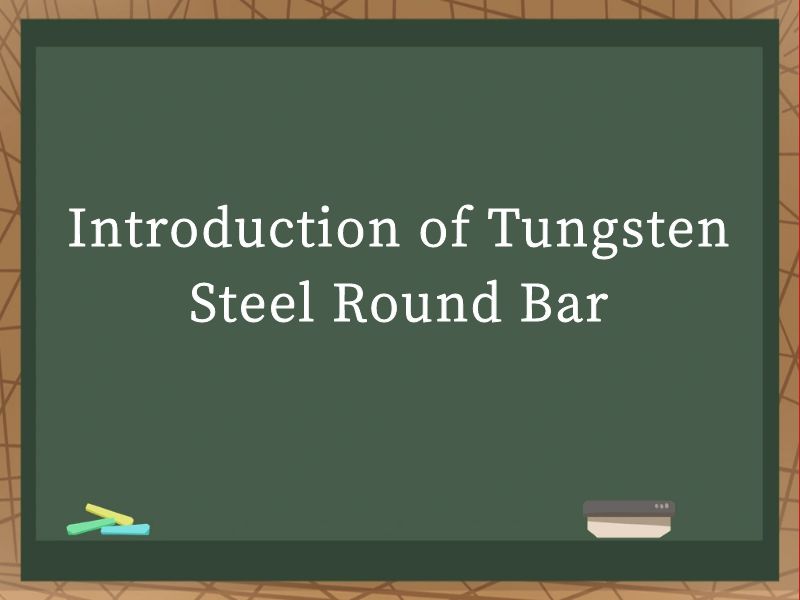JOURNALISM
- NEWS -
|
Introduction of Tungsten Steel Round BarIntroduction of Tungsten Steel Round Bar.Tungsten steel round bar, also known as tungsten carbide rod, is a high-performance material widely utilized across various industries due to its exceptional properties. This article delves into the characteristics, manufacturing processes, applications, advantages, and future prospects of tungsten steel round bars, providing a comprehensive understanding of this remarkable material.
Characteristics of Tungsten Steel Round Bar Tungsten steel round bars are renowned for their unparalleled hardness, wear resistance, and high-temperature stability. The primary component, tungsten carbide (WC), forms a hard crystalline structure when combined with cobalt (Co) or other binders. This composition grants tungsten steel round bars their distinctive properties. Hardness: Tungsten steel round bars exhibit one of the highest hardness levels among metallic materials, typically ranging between 86-94 on the Rockwell hardness scale (HRA). This makes them ideal for applications requiring extreme resistance to scratching, indentation, and wear. Wear Resistance: Due to its hardness and the ability to maintain its properties under heavy loads, tungsten steel round bars exhibit exceptional wear resistance. They are less prone to deformation and can withstand prolonged friction without significant degradation. High-Temperature Stability: Tungsten carbide retains its hardness and strength even at elevated temperatures, making it suitable for applications in high-temperature environments. The cobalt binder phase provides some ductility, preventing brittle fracture at high temperatures. Density: Tungsten steel round bars have a high density, typically around 14.5-15.5 g/cm³, which contributes to their inertia and shock-absorbing capabilities. This density also makes them effective for applications requiring heavy-duty performance. Corrosion Resistance: While tungsten carbide itself is not inherently corrosion-resistant, coatings or surface treatments can enhance its resistance to chemical attack, broadening its application scope. Manufacturing Processes of Tungsten Steel Round Bar The production of tungsten steel round bars involves several intricate steps, from raw material preparation to final shaping and heat treatment. Here’s a detailed look at the manufacturing process: Raw Material Preparation: Tungsten Powder Production: Tungsten ore is processed to extract tungsten oxide, which is then reduced to tungsten powder. This powder serves as the primary raw material for tungsten carbide production. Cobalt Powder Production: High-purity cobalt metal is processed into fine cobalt powder, which acts as the binder in the tungsten carbide composite. Mixing and Milling: Blending: The tungsten powder and cobalt powder are blended in precise proportions to achieve the desired hardness and other mechanical properties. Wet Milling: The blended powders are mixed with a liquid medium (such as alcohol or water) and milled in a ball mill to ensure homogeneous mixing and particle size reduction. Drying and Sieving: The wet mixture is dried and sieved to remove any agglomerates and ensure a uniform particle size distribution. Forming: Pressing: The dried and sieved powder mixture is pressed into the desired shape using hydraulic presses. For round bars, this typically involves pressing the powder into cylindrical molds. Sintering: Pre-Sintering: The pressed blanks are subjected to a pre-sintering process at temperatures below the melting point of cobalt but sufficient to initiate sintering and bond formation. Final Sintering: The pre-sintered blanks are then sintered at higher temperatures, typically between 1300-1500°C, in controlled atmospheres (e.g., inert gas or vacuum) to achieve full densification and bond formation. Post-Processing: Machining: The sintered bars are machined to the final dimensions, including grinding, polishing, and cutting to length. Heat Treatment: Depending on the application, the tungsten steel round bars may undergo additional heat treatment steps to optimize their mechanical properties. Quality Control: Each batch of tungsten steel round bars undergoes rigorous quality control testing, including hardness testing, dimensional inspection, and non-destructive testing to ensure compliance with specifications. Applications of Tungsten Steel Round Bar Tungsten steel round bars find applications in a diverse range of industries due to their unique properties. Here are some notable applications: Cutting Tools: Drills and End Mills: Tungsten steel round bars are used to manufacture drills and end mills for metal cutting operations. Their hardness and wear resistance make them suitable for machining hard materials like steel and cast iron. Reamers and Taps: These tools are used for finishing holes and threading operations. Tungsten steel round bars provide the necessary durability and precision for these tasks. Wear Parts: Nozzles and Valves: Tungsten steel round bars are used in nozzles and valves exposed to abrasive media or high-pressure conditions. Their wear resistance ensures long service life and reduced maintenance. Bearings and Bushings: In applications requiring high load-bearing capacity and wear resistance, tungsten steel round bars are used to manufacture bearings and bushings. Mining and Construction: Drill Bits and Rock Tools: Tungsten steel round bars are ideal for manufacturing drill bits and other rock tools used in mining and tunneling operations. Their hardness and strength allow them to penetrate hard rock formations efficiently. Wear Plates: These plates are used to protect equipment and structures from wear and abrasion in mining and construction environments. Medical and Dental Instruments: Surgical Instruments: Tungsten steel round bars are used to manufacture surgical instruments that require high hardness and corrosion resistance. Dental Burs and Drills: These tools benefit from the hardness and wear resistance of tungsten steel, ensuring precise and durable performance in dental procedures. Energy and Aerospace: Valve Seats and Seals: Tungsten steel round bars are used in valve seats and seals in high-temperature and high-pressure environments, such as those found in turbines and engines. Wear-Resistant Components: Components in aerospace systems that experience high levels of wear, such as landing gear components, benefit from the durability of tungsten steel. Advantages of Tungsten Steel Round Bar The advantages of tungsten steel round bars are numerous and span across various aspects of performance and application: Durability: Tungsten steel round bars offer extended service life due to their high hardness and wear resistance, reducing the frequency of replacements and maintenance. Precision: Their hardness and stability allow for precision machining and consistent performance in applications requiring high accuracy. Versatility: The ability to customize tungsten steel round bars in terms of composition, hardness, and dimensions makes them versatile for a wide range of applications. Temperature Resistance: Their high-temperature stability ensures reliable performance in environments with extreme temperature conditions. Corrosion Resistance (with coatings): While tungsten carbide itself is not corrosion-resistant, coatings can enhance its corrosion resistance, broadening its use in harsh environments. Future Prospects The future of tungsten steel round bars looks promising, driven by advancements in material science and increasing demand from various industries. Here are some key trends and developments: Material Innovations: Researchers are continuously exploring new compositions and manufacturing processes to enhance the properties of tungsten steel round bars, such as improving toughness and corrosion resistance. Sustainability: Efforts are being made to develop more sustainable manufacturing processes, reducing environmental impact and waste. Growth in Emerging Industries: The rise of new industries, such as renewable energy and advanced manufacturing, presents opportunities for tungsten steel round bars. For example, they can be used in wind turbine components and additive manufacturing processes. Customization and Specialization: As industries become more specialized, the demand for customized tungsten steel round bars tailored to specific applications is likely to increase. Global Expansion: Emerging markets, particularly in Asia and Africa, are expected to drive growth in demand for tungsten steel round bars due to rapid industrialization and infrastructure development. In conclusion, tungsten steel round bars are a versatile and high-performance material with a wide range of applications across various industries. Their exceptional hardness, wear resistance, and high-temperature stability make them ideal for demanding applications. As technology advances and new industries emerge, the demand for tungsten steel round bars is poised to grow, driving further innovation and development in this field. Understanding their characteristics, manufacturing processes, and applications is crucial for harnessing their full potential and leveraging their advantages in various industrial contexts. |


